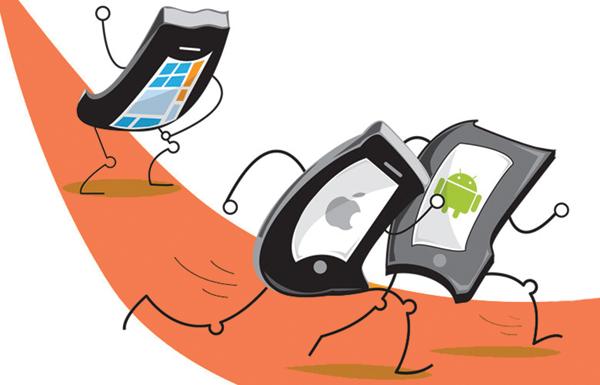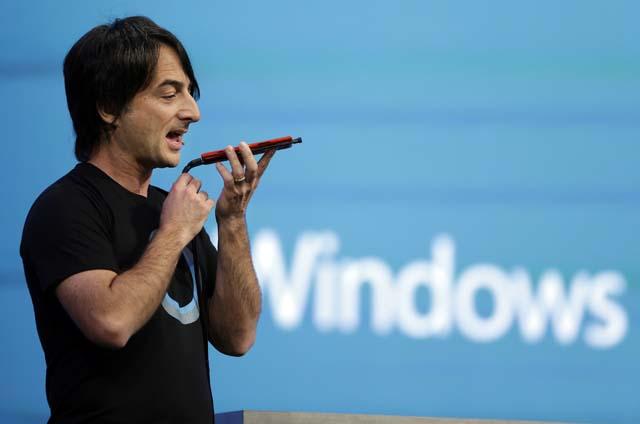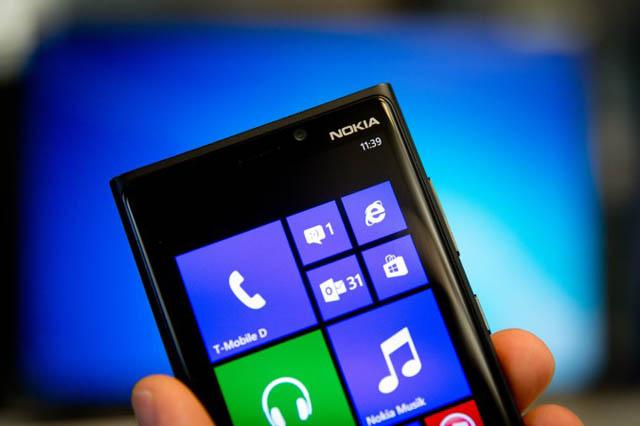You are here
Microsoft takes the long view on smartphone reboot
By The Seattle Times (TNS) - May 02,2016 - Last updated at May 02,2016

Photo courtesy of wordpress.com
SEATTLE — Microsoft, after failing to build a smartphone hub to rival Google or Apple, is trying to change the conversation.
At Microsoft Build, the company’s trade show for software developers, held earlier this year, executives touted ambitions in artificial-intelligence-powered chat bots, cloud computing and other technologies. Barely mentioned as the company outlined its annual technology roadmap was the device in your pocket.
Microsoft’s silence on its smartphones, one technology-industry analyst who attended the conference said, was deafening. It was also symbolic.
The company has spent years and billions of dollars in an effort to replicate its dominance in PC software and move it to smartphones, a realm dominated by Apple’s iPhone and devices using Google’s free-to-use Android operating system.
Microsoft’s ill-fated deal to buy Nokia’s phone business, finalised two years ago, didn’t improve the company’s fortunes. Just 1.1 per cent of smartphones sold during the last three months of 2015 ran the mobile version of Windows, according to researcher Gartner. That’s the lowest quarterly total since Microsoft’s overhauled smartphone business debuted in 2010.
After the Nokia debacle, which included a $7.6 billion write-down and thousands of lay-offs, yet another corporate reboot is under way. “They’ve conceded that they’ve lost the battle for smartphone-operating systems,” said Ed Maguire, who tracks the company at CLSA, a brokerage firm. “After fighting that war for so many years, and watching Nokia go down in flames, nobody would take them seriously if they tried to promote Windows Phone at this point.”
For many people, smartphones have supplanted the PC, Microsoft’s comfort zone, as their primary computing tool. For the company to remain relevant in a world increasingly dominated by such mobile computing, Microsoft cannot ignore the smartphone, analysts say.
Whether that means Microsoft keeps plugging away on its own smartphone platform remains to be seen.
Chief Executive Satya Nadella has said Microsoft remains committed to the smartphone business. Recently, that has been revealed most often as a commitment to other people’s smartphones.
Microsoft has expanded its efforts to make its Office, developer and cloud-computing tools relevant for users of Apple and Google devices. Consumers might have little interest in a Windows smartphone, but many have tapped into Microsoft’s software on the device they do own.
The company also has courted businesses with its cross-platform push.
In a display of that shift, a BMW executive took the stage at Microsoft’s developer show to tout an application the automaker had created for Apple smartphones.
Microsoft’s role? The company’s Azure data-centre network is the infrastructure powering BMW’s app behind the scenes.
“That was the change in thinking that [Nadella] brought to the table,” said Manuel Medina, who spent years in Microsoft’s mobile division before founding Seattle software start-up Outreach. “Instead of having to force somebody to be in the Microsoft ecosystem, they go meet users where they are.”
Maguire said Microsoft’s recognition of its mobile hurdles has led to a reordering of the priorities of the Seattle-area company.
Azure, the fast-growing cloud-computing network, Office, and desktop variants of Windows seem to be the priorities, he said, adding “phone has kind of gone to the back of the line”.
For its own smartphone business, Microsoft is playing the long game.
With Windows 10, Microsoft has an operating system designed to run on everything from laptops to mobile devices and small industrial sensors. The company is betting that consumers will, at some point, stop viewing the smartphone as a separate category of hardware.
A Windows 10 feature called Continuum converts a smartphone’s interface into a limited PC-style desktop view when plugged into a keyboard and monitor. The tool envisions the time when small, portable processors can handle all of the tasks people now associate with a desktop computer.
It might not matter that Microsoft is a minnow on smartphones, the thinking goes, if the line between smartphones and bigger devices blurs in the same way the division between tablets and laptops eroded after the company introduced its Surface tablets.
“Three years from now, I hope that people will look and say, ‘Oh wow, that’s right, this is a phone that can also be a PC,’” Nadella said of Windows 10 smartphones in an interview with Business Insider.
For now, however, the smartphone is clearly a distinct and dominant device.
Gartner estimates 1.5 billion of them will sell this year. The research firm pegs sales of PCs, including tablets and other large-screen portable devices, at 473 million.
Microsoft, like the rest of the smartphone-industry incumbents, was unprepared for the overwhelming popularity accorded to the iPhone after it was introduced in 2007.
Apple made the iPhone a sleek, must-have for consumers in a market until that point made up largely of stodgy business-focused devices. Google’s Android, released a year later, offered phone manufacturers interested in an iPhone-like experience a free alternative, as long as they plugged in to Google’s services.
Developers building everything from mobile banking apps to retail storefronts and games followed consumers to those platforms, usually choosing to forgo the costly step of releasing versions for laggards like Windows Phone or BlackBerry.
Microsoft has been playing catch-up ever since. It took the company three years after the introduction of the iPhone to develop its mobile Windows variant into something that rivaled the Apple experience.
Now, after pulling the plug on Nokia, Microsoft has indicated it will stop trying to out-iPhone the iPhone.
For now, Microsoft is still trying to narrow the app gap that Windows smartphones face versus Google and Apple.
Windows 10 comes with a programming interface designed to make it less costly for companies that have created a desktop programme to repurpose that software to run on smartphones, as well as on the Xbox game console and other devices.
Get enough people running Windows 10, and eventually application makers might take a second look at the smartphone variant, Microsoft hopes.
NPR One, an application from the public-radio network, is that vision in action. The app, which puts listeners into a stream of their favourite local and national radio shows with just a couple of touches, debuted in 2014 for Android and iOS.
This year, with help from Virginia-based software developer InfernoRed, NPR One arrived on Windows 10 PCs, and, after some minor modifications to its visual layout, on Windows 10 smartphones. Soon, it will be available on Xbox game consoles.
There’s one problem with this virtuous circle, though. It was Microsoft that suggested NPR take its app to Windows. Microsoft helped foot the bill.
“That sort of approach is kind of a perennial tactic,” said Jeffrey Hammond, an analyst with Forrester who follows developers. “They’ve done it for years. You take the 100 most used apps [on iOS and Android], and you’re more aggressive to [give them an incentive to come] over.”
But even Microsoft’s industry-renowned developer-relations team, said to number in the hundreds, hasn’t been able to maintain attention on a smartphone platform that lacks a large consumer base.
High-profile companies like American Airlines, Chase Bank, and popular finance tracking service Mint have pulled their applications from Windows smartphones.
“Other than just paying people to develop apps I don’t know how you fix that at this point,” Medina, ex-Microsoft, said.
Related Articles
Microsoft on Wednesday took on Apple’s Siri and Google Now with a smartphone personal assistant dubbed “Cortana”.
First there’s the fact and then there’s what it really means. The fact is that Microsoft finally has bought Nokia’s mobile phones business and all that goes with it: design, manufacturing, sales and technical support.
Microsoft pulled back the curtain Wednesday on the upcoming Windows 10 operating system focused on bringing harmony to the diverse array of Internet gadgets in people’s lives.


















